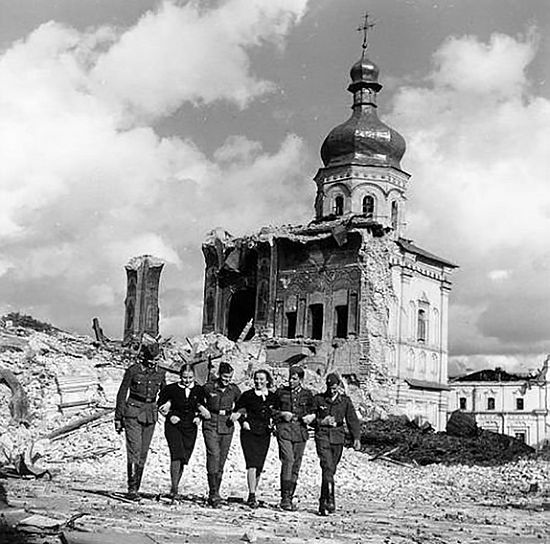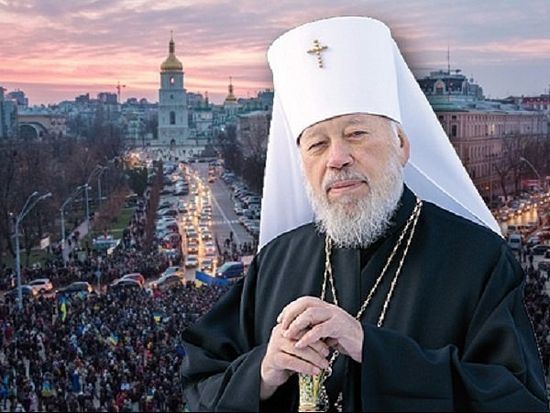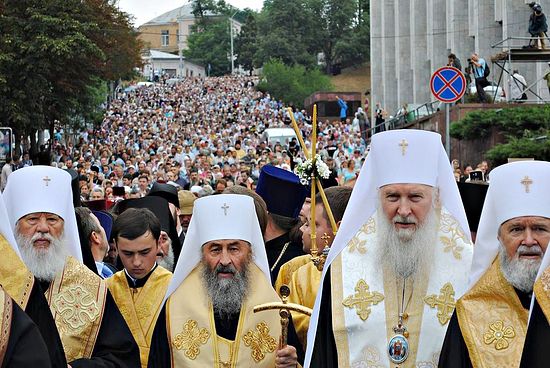Introduction
We are witnessing the fourth and perhaps last attempt to establish an Autocephalous Church in Ukraine, despite the rejection of this idea by the Orthodox episcopate, the monasteries and their elders, the parish clergy and the great majority of active Orthodox believers in that country.
The characteristics of the current attempt follow broadly those of three previous ones, which all ended in failure. That is, interference from outside forces, encouragement from governments, and culture and nationalism overriding theological concerns.
It is important to look at these past events if we are to properly understand what is happening now.
1. Ukraine after the revolution
The February revolution of 1917 ushered in a lengthy period of political and social chaos in Ukraine, as in the rest of the former Russian Empire. An “autonomous government” was succeeded by Bolshevik rule; German-Austrian occupation; the regime of Hetman Skoropadsky; Simon Petlyura's ultra-nationalist government; General Denikin's White Army and finally the Bolsheviks again, after their capture of Kiev in February 1919.1
It was the Bolsheviks who immediately introduced anti-religious legislation and who drew the borders of Soviet Ukraine. The latter were roughly based on the language spoken in the rural areas and did not include Crimea nor the lands now referred to everywhere as western Ukraine.2 The latter was under Polish or Romanian rule.
The beginning of “Autocephaly” as a movement is often dated as June 29, 1919, when the priest Basil Lypivsky served the Liturgy in the Ukrainian language in St Sophia's cathedral in Kiev before a congregation of enthusiastic supporters. He did this without a blessing from his bishop and in fact in direct disobedience to episcopal instructions.
The local Bolsheviks were in those days strongly supportive of Ukrainian nationalism and were also keen to encourage schismatic movements of every kind to weaken the Orthodox Church.
The real break came on October 23, 1921 when Lypivsky's group, with the active support of the Ukrainian Soviet government, created their own church “Rada” and consecrated Lypivsky as Metropolitan of the “Ukrainian Autocephalous Orthodox Church”.
There was one snag. No Orthodox bishop would have any dealings with them at all.
This did not deter the priests and laity of the new “church”; contrary to the canons and dogmatic teachings of the Church, they collectively laid hands on Lypivsky, who then proceeded to “consecrate” five further “bishops”. One was John Theodorovich, whom we shall meet later.
The new Sobor went on to proclaim its complete separation from the Russian Church and denounced the resolutions of the famous Moscow Council of 1918.
From that time no Orthodox body would recognize the “Autocephalists”, and they gained the name “self-consecrated”.3
The Communists also encouraged another schism which was to achieve some success in Russian-speaking cities like Kharkov. This was the Ukrainian branch of the Russian Renovationist schism. It no longer exists as an organized body in either country but it's similarity to the Autocephalists was very close. Both groups introduced married bishops, second marriages for widowed priests, the turning of monasteries into “working collectives”, open support for the soviet authorities (including their persecution of the Orthodox) and hasty liturgical reforms, among them the use of the Ukrainian language in worship.
Of the two groups it is probable that the Renovationists were actually the more conservative. They certainly were able to attract some Orthodox bishops to their schism, which was more than the Autocephalists were able to do. It is significant that rejection or marginalizing of the monastic life will become a constant feature of the autocephalist movement.
What is important here is how much support the “autocephalists” really had. Of course they were backed by the more nationalistic of the intelligentsia, by Petlyura’s followers and by a section of the married parish clergy. However at no time did they form a majority of the Orthodox Christians of Ukraine. At the very representative Church Council that met in June 1918, advocates of autocephaly controlled only a third of the votes,4 while in the mid-1920s, after years of government encouragement (and simultaneous harassment of the canonical Orthodox) the “Ukrainian Autocephalous Church” comprised approximately 2000 clergy and eleven percent of the Orthodox parishes still functioning.5 The great majority of Orthodox believers remained faithful to Patriarch Tikhon and in solidarity with their persecuted brethren in the rest of the soviet state.
By 1929 the Party Line had changed. Stalin began his attack on “bourgeois nationalism”; a plot was of course detected which aimed at restoring private property and detaching Ukraine from the Soviet Union. Many Ukrainian cultural figures disappeared into labor camps and during the 1930s all the autocephalist bishops were arrested (as were those of the canonical Church and even the ever-loyal renovationists). Of the thirty-five “bishops” consecrated by Lypivsky, not one remained alive in Ukraine by 1938. The sole survivor was John Theodorovich, who had earlier been sent to care for Ukrainian immigrants in Canada. Most of these were former Greek Catholics (Uniates) and the autocephalist version of ethnic Orthodoxy suited them nicely.
Theodorovich wrote a passionate theological defence of consecrating bishops without bishops which makes interesting reading.6 It went into three editions, the last of which was in 1947.
In 1949, however, he was persuaded by a section of his clergy to receive a “valid” consecration from a bishop who had received his orders from the Polish Orthodox Church and a rather shadowy Greek bishop who claimed to represent the Church of Alexandria. Many of his Canadian flock deeply objected to this denigration of the memory of Lypivsky, their founding father.7
1. Ukraine under German occupation.
In June 1941, the German armies invaded the Soviet Union without any declaration of war. They penetrated the country so quickly that in three months they had occupied most of Soviet Ukraine.
 Hitler’s soldiers with girls, with ruins of the Dormition Cathedral of the Kiev Caves Lavra in the background. Photo: pravlife.org
Hitler’s soldiers with girls, with ruins of the Dormition Cathedral of the Kiev Caves Lavra in the background. Photo: pravlife.org There were scarcely any churches still open at that time but the German authorities permitted the revival of Church life, and after a period of confusion, due to shifting borders, two rival Orthodox synods of bishops emerged: the so-called Autonomists (who commemorated Metropolitan Sergius—later Patriarch—in Moscow but who had no direct communication with him)8 and the Autocephalists who naturally had no superior. The autocephalist bishops had been consecrated by the Metropolitan of Warsaw and were technically canonical, but they quickly established contact with the surviving clergy of the Lypivsky succession, who made themselves known in the new conditions of religious freedom. What is crucial here is that the bishops did not demand any reordination of such priests but accepted them in their orders. This was done officially and made any communion with the autonomous bishops impossible.9
Another problem with the autocephalous bishops was that they were essentially political figures (the Germans noticed this very quickly, referring to them as politicians in cassocks). The head of the Ukrainian Autocephalist Church in occupied Ukraine, Polycarp Sikorsky, had been head of the chancellery of Petlyura's Council of Ministers during the Civil War; bishop John Ohienko had been Minister of Religion in Petlyura's short-lived government; Palladius Rudenko had been Minister of Finance in the same administration and Mystislav Skrypnyk (many years later to become “Patriarch”) was Petlyura’s nephew and former secretary.10
Despite their contempt for such hierarchs, the German authorities generally favored the autocephalists and “Ukrainianization” over the autonomists, at least until the last phases of the war
There was certainly a great revival of Church life during the brief period of German rule but the actual statistics are unfortunately incomplete. The largest number of churches reopened was in the western half of the country (which was under German rule for longer) and in Kiev.
The capital provides the most complete figures. 798 churches were functioning by 1943, 500 autonomous (i.e. canonical) and 298 autocephalous, served by 600 autonomist and 434 autocephalist priests. Everywhere the majority of parishes were autonomist, in most of the east overwhelmingly so. In Chernigov diocese there were no autocephalous churches at all. All reopened monasteries supported the canonical Church.11
All reports indicate that the fact that the autocephalists accepted Lypivsky-ordained priests was a strong factor in their lack of support among the faithful.
When the Germans were driven out of Ukraine, about half the autonomous bishops and all the autocephalous ones were evacuated with them.12
Autocephalous parishes were established in Europe and the Americas with this second emigration, though they were never recognized by other Orthodox Churches.13 Neither did their bishops ever issue any statement of repentance for the actions of Lypivsky in 1921.
In 1990 the autocephalists in Canada, and in 1994 those in the USA, were accepted into the Ecumenical Patriarchate. This caused some controversy but was finally accepted by other Churches on the grounds that there were no longer any non-ordained priests left alive.
In Soviet Ukraine the autocephalists ceased to exist as a legal body.
3. Post-communist Ukraine
The events after Perestroika are well documented. The lifting of all restrictions on religious freedom led to the re-emergence of the Ukrainian Greek Catholic Church and, on a much smaller scale, of the Ukrainian Autocephalous Church.
A period of confusion followed.
The Metropolitan of Kiev, the most senior member of the Russian Orthodox Church after the Patriarch, was Philaret Denisenko who was expected to be elected next Patriarch of Moscow. This did not happen.
Meanwhile the Autocephalist Church had been revived and Mstyslav Skrypnik (aged 92) was summoned from America to be their first “Patriarch”. He was “enthroned” in 1990 but later returned to his home in New Jersey.
Metropolitan Philaret, now allied to his friend President Kravchuk, announced that he was joining the revived Autocephalist church as exarch for Mstyslav. There was much opposition to this and after the death of Mstyslav, in 1993, two rival uncanonical autocephalist churches emerged. They called themselves the Ukrainian Orthodox Church (Kiev Patriarchate)—under Philaret, who proclaimed himself Patriarch—and the Ukrainian Autocephalist Orthodox Church under Patriarch Dimitry Yarema. This is still the situation. The two groups have exactly the same views about Ukrainian autocephaly but cannot agree about the controversial figure of Philaret and his leadership. After the death of Dimitry in 2000, the head of the UAOC no longer used the patriarchal title and established close ties with the Orthodox Ukrainians of Canada (and therefore indirectly with Constantinople).
Meanwhile the Orthodox episcopate of Ukraine completely rejected Philaret's path and elected a new Metropolitan of Kiev, Vladimir Sabodan. Until October 2018 his was the only local Church in Ukraine recognized by the Orthodox world. Most of the parishes and practically all the monasteries and convents gathered under Metropolitan Vladimir.
It has been repeated many times that the canonical Ukrainian Orthodox Church under Metropolitan Vladimir, and since his death in 2014, under Metropolitan Onuphry, holds the vast majority of the Orthodox parishes, monasteries and seminaries in the country. It is the only group to be found in every part of Ukraine, and in some provinces it is without any autocephalist rivals at all.
What is not sufficiently appreciated is that the two uncanonical bodies are also highly localized. The small UAOC, which is shrinking fast, is virtually confined to three western provinces which together comprise much of the old Austrian “Galicia”—in other words the people there are former Greek Catholics (“Uniates”) or their descendants, for this region was almost without an Orthodox population before the Second World War.14
Even the “Kiev Patriarchate” is thin on the ground in the south, east and northern provinces of the country. It’s great strength is again in Galicia, plus Volhyn and Rovno (in the far west) and Kiev province. Even in these latter three regions it is far exceeded by the canonical Church.
In other words both uncanonical churches receive their main support from only three provinces out of the 26 provinces of Ukraine. These are Lviv, Ivano-Frankivsk and Ternopil, which are also the most nationalistic and anti-Russian regions and the ones where the Ukrainian language is most used.15
It is clear that this third attempt, in the 1990s, to establish an independent Orthodox church, antagonistic towards the Moscow Patriarchate, was defeated by Orthodox believers themselves.
During this period a new factor emerged: both Philaret and Pesident Kravchuk visited Patriarch Bartholomew in Istanbul at different times to seek his help in the establishment of an autocephalous church. The patriarch reiterated his unconditional support for Metropolitan Vladimir and the Ukrainian Orthodox Church—the autonomous Church of the Moscow Patriarchate. This continued to be the policy of the Constantinopolitan Patriarchate for many years to come.
4. Last try?
As this is being written (October 2018) a fourth attempt to establish Ukrainian autocephaly is underway.
The scenario follows closely that of the early 1990s but with two important additional factors. President Poroshenko, like Kravchuk before him, has visited Patriarch Bartholomew to ask for him to directly intervene in establishing a single united Orthodox Church entirely separate from Moscow and including the two uncanonical bodies. This time Constantinople has agreed. At first Bartholomew and his supporters seemed to be basing this change of mind (and gross interference in the affairs of another Church), on his role as Orthodox primate (using quasi-Papal language). Later it turned out that Ukraine was now regarded in Istanbul as having always been part of the Ecumenical Patriarchate—the past 350 years having been forgotten.
The second new circumstance is the tacit support for autocephaly from the American government though how far this will be acted on is still obscure.16
But as this article was being finished, two interesting events occurred. On October 14 (the Feast of the Protection of the Virgin) a much publicized rally was held in central Kiev to celebrate the hoped for united Church. Speeches were given by the President (of a supposedly secular state), Philaret and the Metropolitan of the UAOC. The crowd, which was not vast, shouted and waved national flags. No one at all seemed to be holding an icon. For anyone with any personal knowledge of Church life in Ukraine this would have sent an unmistakeable message: these events are not supported by the faithful.17
Then was made public an earlier letter from Patriarch Irenej of Serbia to the Patriarch of Constantinople condemning the whole notion of granting autocephaly to schismatics and interfering in the affairs of the Russian Orthodox Church. Patriarch Irenej reveals that very recently Patriarch Bartholomew had reassured him that only Metropolitan Onuphry was recognized by the Phanar. He also mentions the outrageous activities of Philaret in the Balkans, including concelebrations with a group of priests calling themselves the Church of Montenegro (an unheard-of entity).18
Will this bring some to their senses?
I only want to add that despite the seemingly overwhelming odds stacked against the canonical Ukrainian Church, this fourth try will not succeed if the believing Orthodox people—bishops, priests, monks and nuns, and above all the faithful laity—stand firm, as they have always done.
Our God whom we serve is able to deliver us from the burning fiery furnace, and he will deliver us out of thine hand, O king. But if not, be it known unto thee, O king, that we will not serve thy gods, nor worship the golden image which thou hast set up (Daniel 3.17-18).
This article, the work of an Orthodox layman living in the United Kingdom, has sacrificed much important detail in order to emphasize the parallels between four historical movements. A great deal more information can be found by following up the footnotes.
















Has not the Patriarch of Moscow already elected another choice?
That choice was "NO".
That choice was to establish Moscow once and for all as the 3rd Rome, and allow the modernist, papist, --- now former EP --- to fade into insignificance...
===================